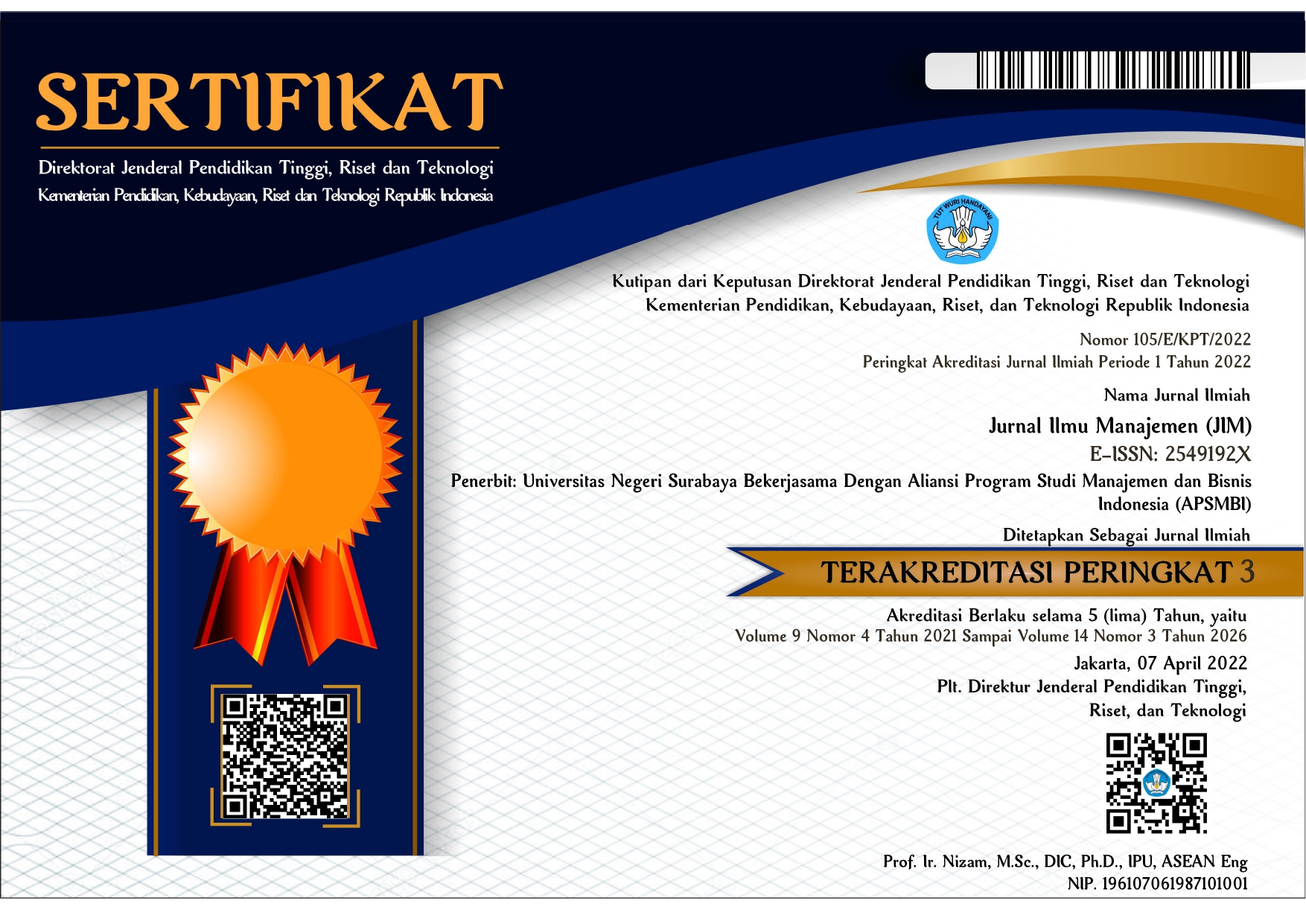Pengaruh Push, Pull, dan Mooring terhadap Switching Intention pada Konsumen Pengguna Wifi di Era Pandemi Covid-19
DOI:
https://doi.org/10.26740/jim.v9n4.p1537-1548Keywords:
mooring effect, pull effect, push effect, switching intention, wifiAbstract
Internet use during the current pandemic is increasing, and most are done online. Work From Home (WFH) and School From Home (SFH) require stable and smooth internet. In addition to the internet, smartphones also play an essential role in people's daily lives during restrictions due to the pandemic. This study aims to analyze and discuss the effect of push, pull and mooring on switching intention. This study uses a push-pull-mooring model with an approach through switching intention. Respondents in this study were at least 20 years old. Due to this age, respondents have entered the adult stage in switching intentions from internet data packages to wifi. The sample used is 110 respondents—the sampling method used non-probability sampling with the judgmental sampling method. The analysis technique uses multiple linear regression with SPSS26 software. Based on the results obtained, it is known that the push variable on switching intention to use wifi has a positive effect. The pull variable has a positive impact on switching intention to use wifi. When the push and pull are getting stronger, consumers will switch. Mooring variable does not affect internet data packet switching intention to private wifi. This result shows that the switching intention of data packets to use wifi privately at home is relatively high. Due to using private wifi, you can access or surf the internet at a stable speed compared to data packet internet, in contrast to using data packet internet whose network is unstable.
References
Akurat.co. (2020). Riset: Permintaan Layanan Internet Meningkat Saat Pandemi. Akurat.Co. (https://akurat.co/riset-permintaan-layanan-internet-meningkat-saat-pandemi?page=all diakses pada 15 Juli 2021)
Bogue, D. J. (1969). Principles of demography. New York: John Wiley.
Bolye, P.J. and Halfacree, K. (1998). Migration and Gender in the Developed World. New York: Longman Press.
Databoks.katadata.co.id (2020). Orang Indonesia Habiskan Hampir 8 Jam untuk Berinternet. Databooks.Katadata.Co.Id. (https://databoks.katadata.co.id/datapublish/2020/02/26/indonesia-habiskan-hampir-8-jam-untuk-berinternet diakses pada 20 Juli 2021)
Djkn.kemenkeu. (2020). WFH di Tengah Pandemi COVID-19. Djkn.Kemenkeu. (https://www.djkn.kemenkeu.go.id/kpknl-jakarta1/baca-artikel/13177/WFH-di-Tengah-Pandemi-COVID-19.html diakses pada 15 Juli 2021)
Gajimu.com. (2020). FAQ Seputar Ketenagakerjaan Terkait Pandemi COVID-19. Gajimu.Com. (https://gajimu.com/tips-karir/kondisi-kerja-dan-kehidupan-di-tengah-pandemi-covid-19-indonesia/faq-ketenagakerjaan-dan-covid-19 diakses pada 15 Juli 2021)
Gizmologi.id. (2019). perbedaan-koneksi-wifi-data-seluler-pada-smartphone. Gizmologi.Id. (https://gizmologi.id/news/tech/perbedaan-koneksi-wifi-data-seluler-pada-smartphone/ diakses pada 15 Juli 2021)
Jasmine, C. A. (2020). Impacts of Covid-19 on Company and Efforts to Support Organization Adaptable. SSRN Electronic Journal, April. https://doi.org/10.2139/ssrn.3590726
Keaveney, S. M. (1995). Customer Switching Behavior in Service Industries: An Exploratory Study. Journal of Marketing, 59(2), 71. https://doi.org/10.2307/1252074
Malhotra, N. . (2009). Riset Pemasaran. Jakarta: PT. Indeks.
Newssetup.kontan.co.id. (2021). wfh-bikin-pelanggan-wifi-republic-meningkat-drastis. Newssetup.Kontan.Co.Id. (https://newssetup.kontan.co.id/news/wfh-bikin-pelanggan-WI-republic-meningkat-drastis diakses pada 15 Juli 2021)
Pangestu, L., & Sanaji, S. (2020). Customer value migration pada platform bermain online games. KINERJA, 17(2), 215-221.
Putri, A. V., & Irwansyah, I. (2020). Communication Patterns and Media Technology Role in Organization and Society During Pandemic. The Journal of Society and Media, 4(2), 228-261. https://doi.org/10.26740/jsm.v4n2.p228-261
Retaildive.com. (2017). Why social shopping is the next big thing for mobile. Retail Dive.com. (https://www.retaildive.com/ex/mobilecommercedaily/why-social-shopping-is-the-next-big-thing-for-mobile diakses pada 18 Juli 2021
Downloads
Published
How to Cite
Issue
Section
License
Copyright (c) 2021 Jurnal Ilmu Manajemen

This work is licensed under a Creative Commons Attribution-NonCommercial 4.0 International License.
 Abstract views: 1183
,
Abstract views: 1183
, PDF Downloads: 2573
PDF Downloads: 2573










